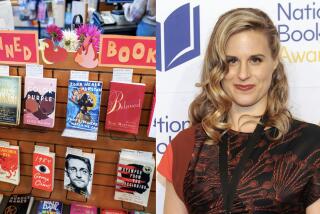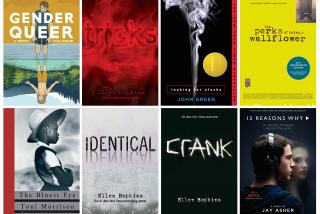In 2017, publishing really needs a blockbuster

This year, publishing needs a hit.
Not that 2016 was bad; it was fine. Books sales basically held steady — down a little here, up some there — for the most recent period for which we have numbers, from January to July. Although the Assn. of American Publishers wants to crow about the fact that books for children and teens were up quite a bit, overall, trade books sales were down 0.4% in 2016 from the same period in 2015.
Which isn’t terrible. But it isn’t good, or at least, not good enough.
What publishing needs is one book, one big book, that comes out of nowhere and takes America by storm. You know what I mean: You hear people talking about it in line at the grocery store. Your grandmother asks if you’ve read it and the same day your college roommate does. It’s the book you see people reading on subways and on planes, that you hear about on the radio and on TV talk shows, that seems to be everywhere at once.
In 2015, that book was “The Girl on the Train.” In 2012, it was “Gone Girl.” Before that came “The Girl With the Dragon Tattoo,” “The Girl Who Played With Fire” and “The Girl Who Kicked the Hornet’s Nest” (2008, 2009 and 2010, respectively).
Girls, girls, girls!
Indeed, it’s a trend. Once one of these books becomes a mega-hit, publishers look for ways to hitch their wagons to the lead horse. Gillian Flynn certainly wasn’t copying Stieg Larsson’s trilogy with her book “Gone Girl” — the title was the name of a Johnny Cash album way back in 1978 — but publishers surely noticed. And “The Girl on the Train” which, like “Gone Girl,” features an unreliable female narrator, got a huge marketing push. “I know it should be ‘The Woman on the Train,’ but it didn’t scan,” author Paula Hawkins (annoyed at the comparison) told the Hollywood Reporter.
The piling on once a book gets mega-successful may be dismaying from a creative standpoint, but from a business perspective it makes sense: The big hits are impossible to predict.
If I had told you in 1996 that a boy wizard, a girl torn between a vampire and a werewolf, kids fighting to the death in a dystopia, teens with cancer and a Harvard symbologist would take our bestseller lists by storm, would you have believed me — or called a psychiatrist?
Dan Brown had published three quiet thrillers — including one featuring Robert Langdon — before his second Langdon book, “The Da Vinci Code,” was published. It was the bestselling book of 2004 — and, in 2003 and 2005, the #2 bestseller. It spawned not only its own sequels and movies but shelves and shelves of imitators filled with art and religious conspiracies.
The book that denied Brown the top spot in 2003 was J.K. Rowling’s “Harry Potter and the Order of the Phoenix.” Her massively successful Harry Potter series showed publishing that books for kids could lead the industry, re-energizing it with huge sales. But Rowling stopped writing the Harry Potter series in 2007 with “Harry Potter and the Deathly Hallows,” the year’s bestselling book.
By then, her fans were growing into teens with book-buying power. Some turned to Stephenie Meyer’s vampire romance “Twilight” series; some snapped up “The Hunger Games” books by Suzanne Collins; many went for John Green’s “The Fault In Our Stars.”
These books aren’t much like one another. And although “Fifty Shades of Grey” was, at its very first imaginings, “Twilight” fan fiction, E.L. James’ erotic novel, which was 2012’s bestselling book overall, became something entirely new that launched its own fleet of hot-and-heavy followers.
What these breakthrough books share is that they came out of nowhere to top bestseller lists. They each established a real and meaningful presence in our culture. They told us something, reflected back something or encouraged us to imagine something that was fresh and new.
All the while there were perennial bestselling authors making appearances: Stephen King, John Grisham, Nora Roberts and James Patterson are regularly among the year’s bestsellers. Jeff Kinney has made a place for himself with his “Wimpy Kid” children’s series. Occasionally, literary authors such as Jonathan Franzen and Anthony Doerr find a place among the year’s biggest books.
But in 2016, there wasn’t a breakthrough hit of any kind.
It’s not for want of trying — there are thousands of books published each year, with the authors and businesspeople behind them hoping each will resonate with readers, marketers strategizing the best they can. But one of the charms of the publishing industry is that it’s hard to tell what will catch on — in fact, the biggest books, the ones that really make a mark, are those that come as a surprise.
What look to be this year’s top 10 are a lot of usual suspects. The top-selling book of the year, with 4.3 million copies sold as of late December, is by a familiar bestselling writer. But it’s a strange sort of book: “Harry Potter and the Cursed Child — Parts One and Two” by J.K. Rowling, John Tiffany and Jack Thorne is the official script book (hardly a book at all, really) of the original London production of the play about a grown-up Harry Potter.
As far as sales go, it’s ahead by miles: Its closest competitors, as of the third week of December, are “Killing the Rising Sun” by Bill O’Reilly and Martin Dugard, which has sold about 960,000 copies, and Jeff Kinney’s latest Wimpy Kid book, “Double Down,” with 974,000 copies.
Meanwhile, the book version of Rowling’s screenplay for “Fantastic Beasts and Where to Find Them” has sold another 500,000 copies, putting it in or near the year’s top 10. Both of these Harry Potter-related books are categorized as children’s fiction by Nielsen and Publishers Weekly — which is a reason why headlines about a dramatic uptick in children’s book sales should be taken with a grain of salt. It’s mostly Rowling.
Publishing can’t keep living off the fumes of the boy wizard. We will eventually face the issue of diminishing returns.
We can always have more of the books we know readers love. Even Lisbeth Salander, whose creator Stieg Larsson died before his novels became bestsellers, returned in 2015 — in a book written by David Lagercrantz, which didn’t sell as well. James can only retool “Fifty Shades of Grey” so many times before the appeal wears thin. Meyer left “Twilight” behind and sold respectably well with her first thriller, “The Chemist,” but readers didn’t follow in droves. Brown is bringing Langdon back in “Origin” in 2017, but can we expect the Harvard symbologist to save us yet again?
As much as I admire all these authors and their work, we need someone new. A new J.K. Rowling, Stephenie Meyer, E.L. James, a new Dan Brown or a new “girl.” A book and story and character that captures our imagination. Something we never expected that can sweep us all away.
More to Read
Sign up for our Book Club newsletter
Get the latest news, events and more from the Los Angeles Times Book Club, and help us get L.A. reading and talking.
You may occasionally receive promotional content from the Los Angeles Times.







